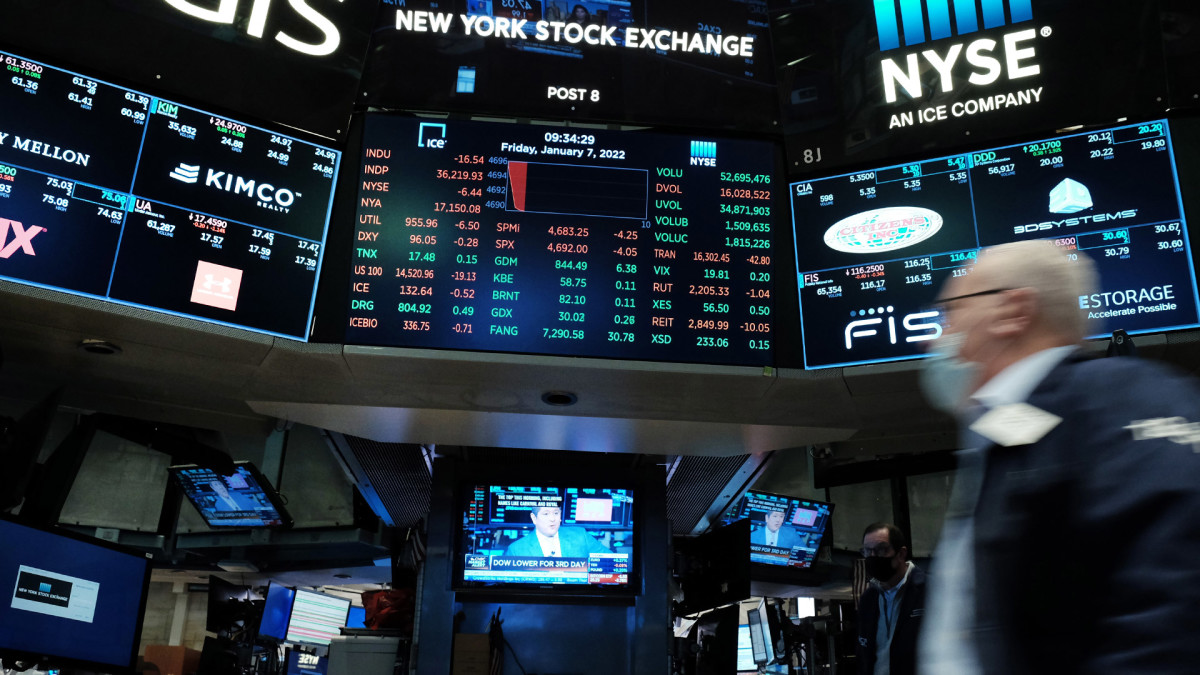
The stock market's performance since mid-July was so poor that the S&P 500 tumbled nearly 10% through October, a drop large enough for Wall Street to label it a correction.
The decline was likely surprising to many, given the stock market’s double-digit returns in the first-half of 2023 were among the best on record, surpassing the average 10% historical annual return since 1993.
One person who wasn't surprised, however, was analyst Carley Garner. On July 19 – almost to the day of the S&P 500's peak –Garner warned investors that "odds favor a market correction" because people were too bullish, the U.S. dollar was poised to rally, and strengthening seasonal headwinds.
Garner's bearish prediction was spot on. The U.S. Dollar soared by over 8%, and, sure enough, stocks tumbled.
Recently, Garner updated her outlook on what could happen next to stocks, including an eye-popping new price target.

Spencer Platt/Getty
The soaring dollar takes a toll on the stock market
The Federal Reserve battle with inflation has caused it to increase the Federal Funds Rate by 5.25% since March 2022. The sharp increase in rates has hamstrung the economy as higher interest rates on loans and a hesitancy by banks to lend to all but the most credit-worthy has reduced spending.
Households have shifted budgets to necessities from discretionary goods and services, businesses have shelved expansion plans, and gross domestic product stagnated in the first half of 2023.
That wasn't good news for corporate sales or profit, especially since inflation, while falling, remained historically high. However, stocks tend to price in bad news ahead of time, and last year's bear market wasn't an exception. As a result, stocks climbed a steep wall of worry in the first six months, with the S&P 500 gaining 20% through mid-July, when Garner warned investors about a looming risk of a correction.
The dollar's strength since July stemmed from growing concern that the central bank would be forced to keep interest rates higher for longer than many hoped. Up until summer, key commodities, like oil and gasoline, had been retreating, adding conviction to those thinking that the Fed would unlikely raise interest rates any further.
However, as the summer progressed, oil and gasoline prices rebounded, sparking concern about future rate increases. The long-term Treasury yields climbed, taking the dollar higher. In turn, the dollar's strength crimped overseas demand at multinational companies, and increased headwinds associated with converting foreign sales back into dollars.
The combination of rising Treasury yields, particularly a move in the 10-year Treasury note yield from below 4% to 5%, dollar strength, sticky inflation, and rebounding risk of a recession proved too much for stocks to overcome.
It certainly didn't help matters that, as Garner pointed out in July, stocks tend to suffer a summertime swoon as volume dries up because of Wall Street vacations.
The stock market rallies, and gains may continue
There's still plenty to worry investors, however, just as sentiment was too bullish in July, it became too bearish in October.
A three-month stretch of losses pushed most measures of investor confidence to lows coincident with an oversold rally, and true to form, the S&P 500 has performed remarkably well since the calendar flipped from October to November.
More From Wall Street Analysts
- Tesla analyst who told investors to ‘nail down profits’ in August has a new price target
- Hedge Fund Manager Doug Kass correctly said to sell stocks in July; here’s what he’s doing now
- Analyst who predicted Nvidia's stock sell-off has a new price target
The benchmark stock market index has climbed over 7% from its late October low, and similar to earlier this year, technology stocks have led the charge.
For example, the technology-heavy Nasdaq 100 ETF QQQ is up nearly 9%, and closely-watched technology titans Nvidia NVDA and Microsoft MSFT are up 19% and 11%.
While those are impressive returns in a short span of time, Garner thinks the rally may have more room to run higher.
In a recent post on Real Money Pro, Garner said that a recent drop in stock market volatility suggests bulls may be firmly back in control.
"The collapse in the VIX (CBOE Volatility Index), which measures the implied volatility in the S&P 500 options market, suggests we are witnessing a regime change from an environment of high volatility selloffs to a slower-paced grind higher," wrote Garner. "Implied volatility is the amount of premium speculators or hedgers are willing to pay for put exposure. The implosion of this premium is a tell-tale sign of a shift in sentiment that should favor the bull camp."
If investors aren't interested in paying up to hedge portfolios by buying put options, it likely means they feel they're already hedged enough. If so, the inclination may be more toward removing those hedges than increasing them, supporting stock market returns.
Garner is also encouraged by what's she's heard recently from the Federal Reserve concerning interest rates.
"The Federal Reserve has yet to close the door on another interest rate hike, but the central bank has made it clear that they recognize the risk of going too far and respect that," said Garner. "The odds of overshooting interest-rate policy are significant."
The central bank's decision to keep rates unchanged in September and November speaks to their understanding of the risk of tightening too much. It's possible we won't see another increase anytime soon, given the Chicago Mercantile Exchange's FedWatch tool puts odds of an increase in December below 10%. It was 37% one month ago.
Garner also points out that stocks typically enjoy seasonal tailwinds over the coming months.
"Bulls also have a tailwind in the form of bullish seasonality working in their favor. The next seasonal bullish push starts on or about November 20 through the first week of December, then fires up again from Christmas through New Year's Day," wrote Garner.
Seasonality doesn't have to repeat, but just as it was a headwind for stocks in July, it's a tailwind for them now.
How high could the S&P 500 climb? Garner thinks the S&P 500 could pullback toward 4,330, and if it holds there, it could climb to 4,730, based on technical analysis.
"Perhaps the most recent correction was the last chance for the bears to capitalize on the fear of higher rates, political turmoil, etc." concluded Garner. "This a bull market, folks."
Sign up for Real Money Pro to see what stocks could be winners.






